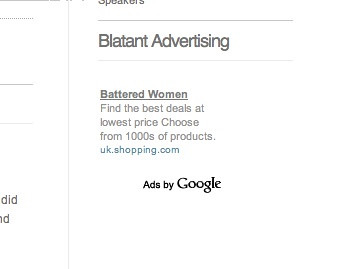Today, you would have heard that Newsgator, Bloglines, Me.dium, Peepel, Talis and Ma.gnolia have joined the APML workgroup and are in discussions with workgroup members on how they can implement APML into their product lines. Bloglines created some news the other week on their intention to adopt it, and the announcement today about Newsgator means APML is now fast becoming an industry standard.
Google however, is still sitting on the side lines. I really like using Google reader, but if they don?¢‚Ǩ‚Ñ¢t announce support for APML soon, I will have to switch back to my old favourite Bloglines which is doing some serious innovating. Seeing as Google reader came out of beta recently, I thought I?¢‚Ǩ‚Ñ¢d help them out to finally add a new feature (APML) that will see it generate some real revenue.
What a Google reader APML file would look like
Read my previous post on what exactly APML is. If the Google reader team was to support APML, what they could add to my APML file is a ranking of blogs, authors, and key-words. First an explanation, and then I will explain the consequences.
In terms of blogs I read, the percentage frequency of posting I read from a particular blog will determine the relevancy score in my APML file. So if I was to read 89% of Techcrunch posts ?¢‚Ǩ‚Äú which is information already provided to users ?¢‚Ǩ‚Äú it would convert this into a relevancy score for Techcrunch of 89% or 0.89.
APML: pulling rank
In terms of authors I read, it can extract who posted the entry from the individual blog postings I read, and like the blog ranking above, perform a similar procedure. I don?¢‚Ǩ‚Ñ¢t imagine it would too hard to do this, however given it?¢‚Ǩ‚Ñ¢s a small team running the product, I would put this on a lower priority to support.
In terms of key-words, Google could employ its contextual analysis technology from each of the postings I read and extract key words. By performing this on each post I read, the frequency of extracted key words determines the relevance score for those concepts.
So that would be the how. The APML file generated from Google Reader would simply rank these blogs, authors, and key-words – and the relevance scores would update over time. Over time, the data is indexed and re-calculated from scratch so as concepts stop being viewed, they start to diminish in value until they drop off.
What Google reader can do with that APML file
1. Ranking of content
One of the biggest issues facing consumers of RSS is the amount of information overload. I am quite confident to think that people would pay a premium, for any attempt to help rank the what can be the hundreds of items per day, that need to be read by a user. By having an APML file, over time Google Reader can match postings to what a users ranked interests are. So rather than presenting the content by reverse chronology (most recent to oldest); it can instead organise content by relevancy (items of most interest to least).
This won?¢‚Ǩ‚Ñ¢t reduce the amount of RSS consumption by a user, but it will enable them to know how to allocate their attention to content. There are a lot of innovative ways you can rank the content, down to the way you extract key works and rank concepts, so there is scope for competing vendors to have their own methods. However the point is, a feature to ?¢‚ǨÀúSort by Personal Relevance?¢‚Ǩ‚Ñ¢ would be highly sort after, and I am sure quite a few people will be willing to pay the price for this God send.
I know Google seems to think contextual ads are everything, but maybe the Google Reader team can break from the mould and generate a different revenue stream through a value add feature like that. Google should apply its contextual advertising technology to determine key words for filtering, not advertising. It can use this pre-existing technology to generate a different revenue stream.
2. Enhancing its AdSense programme
Targeted advertising is still bloody annoying
One of the great benefits of APML is that it creates an open database about a user. Contextual advertising, in my opinion is actually a pretty sucky technology and its success to date is only because all the other types of targeted advertising models are flawed. As I explain above, the technology instead should be done to better analyse what content a user consumes, through keyword analysis. Over time, a ranking of these concepts can occur ?¢‚Ǩ‚Äú as well as being shared from other web services that are doing the same thing.
An APML file that ranks concepts is exactly what Google needs to enhance its adwords technology. Don?¢‚Ǩ‚Ñ¢t use it to analyse a post to show ads; use it to analyse a post to rank concepts. Then, in aggregate, the contextual advertising will work because it can be based off this APML file with great precision. And even better, a user can tweak it ?¢‚Ǩ‚Äú which will be the equivalent to tweaking what advertising a user wants to get. The transparency of a user being able to see what ‘concept ranking’ you generate for them, is powerful, because a user is likely to monitor it to be accurate.
APML is contextual advertising biggest friend, because it profiles a user in a sensible way, that can be shared across applications and monitored by the user. Allowing a user to tweak their APML file for the motivation of more targeted content, aligns their self-interest to ensure the targeted ads thrown at them based on those ranked concepts, are in fact, relevant.
3. Privacy credibility
Privacy is the inflation of the attention economy. You can?¢‚Ǩ‚Ñ¢t proceed to innovate with targeted advertising technology, whilst ignoring privacy. Google has clearly realised this the hard way by being labeled one of the worst privacy offenders in the world. By adopting APML, Google will go a long way to gain credibility in privacy rights. It will be creating open transparency with the information it collects to profile users, and it will allow a user to control that profiling of themselves.
APML is a very clever approach to dealing with privacy. It?¢‚Ǩ‚Ñ¢s not the only approach, but it a one of the most promising. Even if Google never uses an APML file as I describe above, the pure brand-enhancing value of giving some control to its users over their rightful attention data, is something alone that would benefit the Google Reader product (and Google?¢‚Ǩ‚Ñ¢s reputation itself) if they were to adopt it.
Privacy. Stop looking.
Conclusion
Hey Google – can you hear me? Let’s hope so, because you might be the market leader now, but so was Bloglines once upon a time.



